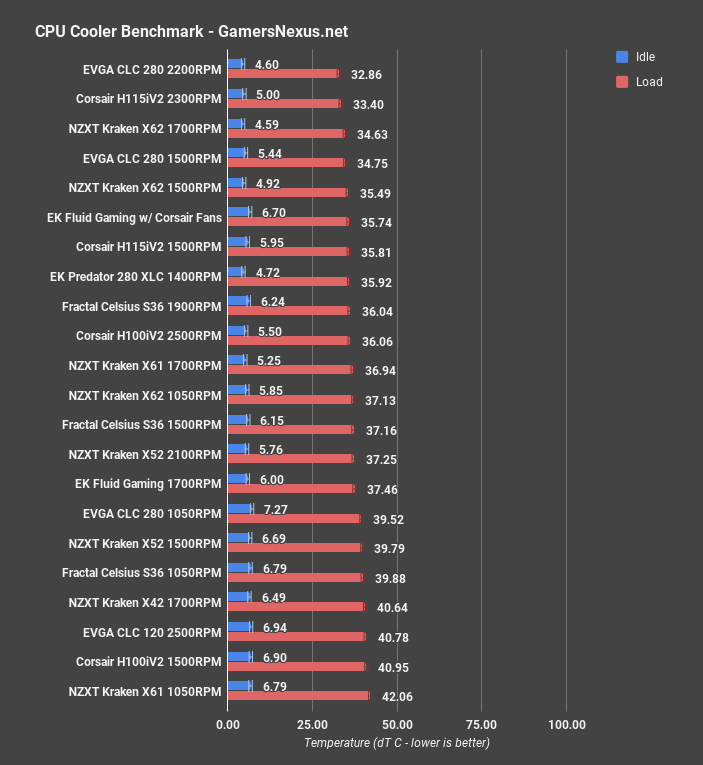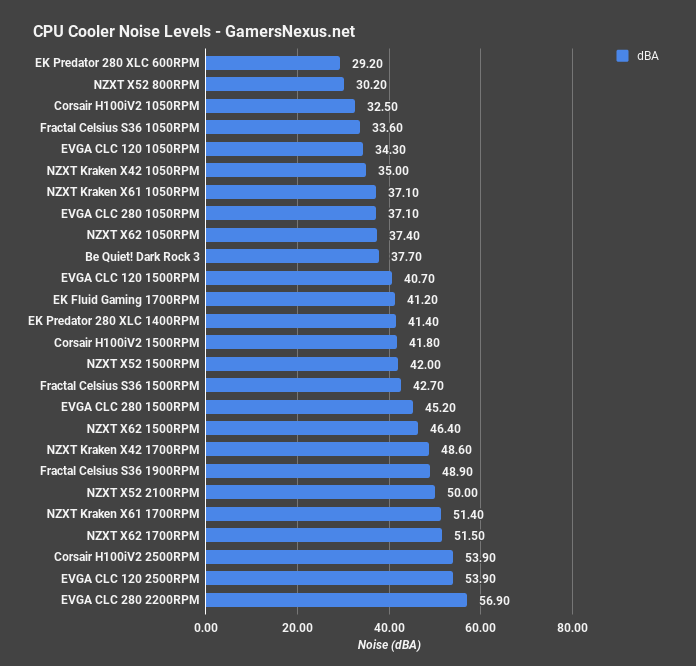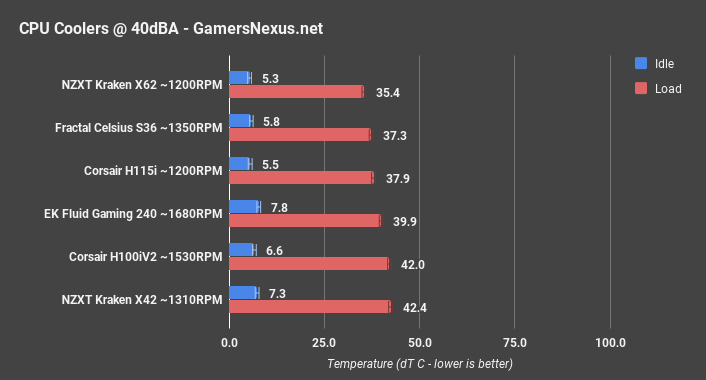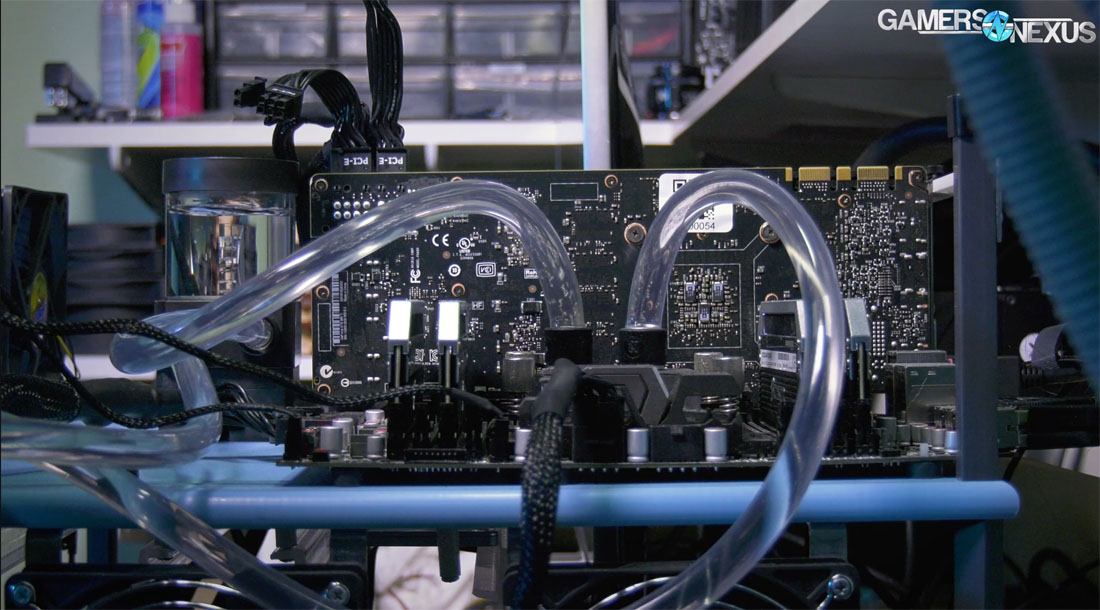EK’s Fluid Gaming liquid cooling kits target an entry-level, first-time loop-builder, strictly using aluminum across all Fluid Gaming components for reduced cost. This decision positions EK nearly against itself: The company has boasted copper loop materials as superior to CLCs for so long now that shipping an aluminum-built product has inspired official blog posts in defense of the choice. This is primarily one of cost, as opting for aluminum – much like the CLC makers – allows EK to sell entry-level, CPU-only kits in the sub-$200 market. The EK Fluid Gaming 240mm solution ships at $160 and includes a 240mm radiator, a standalone pump, soft tubing, coolant (but buy your own distilled water), two fans, fittings, and a CPU block. The result is a low-end open-loop starter pack that includes all necessary parts, but ultimately costs more than nearby CPU-only CLCs (like the H100iV2 at $110, the EVGA CLC 280 at $130, and the Kraken X62 at $156).
Of course, the idea is to go beyond CPU-only cooling: This starter kit is accompanied by a full Fluid Gaming version from EK, priced at $240 and equipped with a Pascal GPU block. In total, EK’s available Fluid Gaming kit options include:
- EKWB Fluid Gaming A120 Single Kit ($150 on Newegg)
- EKWB Fluid Gaming A240 Dual Kit ($160 on Newegg)
- EKWB Fluid Gaming A240G Kit + GPU Block ($240 on Newegg)
- Expansion packs are available with additional radiators and tubing
The A120 is a complete joke of a kit, first of all, and has no business existing. At $150, it’s a $10 jump to EK’s own 240 kit, a $50 drop to a Corsair 240 CLC, and significant drops down to something like the EVGA CLC 120 (at $85).
The A240 costs the same as a blinged-out CLC or more than cheaper CLCs, but offers two items of potential value: (1) The fans are a bit better than most pre-installed CLC fans, as we’ll show in testing in a moment, and (2) the loop can be expanded later, something that most CLCs can’t do (exceptions apply, like Fractal’s Celsius series, odd in its own right).
Today, we’re reviewing the EK Water Blocks Fluid Gaming A240 in its standalone, CPU-only format. This is a product you can buy, so we figured we’d review it like this to start. Opening the loop to the GPU kit is a possibility at a later time, but we’ll start with answering the question of whether a custom loop (sort of) 240mm kit can outperform a closed-loop 240mm kit. This testing includes noise-normalized testing at 40dBA to test both thermals and noise simultaneously, but also tests at max fan/pump RPM for thermals and noise.
For some preliminary, non-test information, we also built our first open loop using this EK kit. We typically don’t talk about this sort of information in a review, but that perspective may align with many of our readers and viewers. From the standpoint of ease-of-installation and setup, EK’s done an OK job at giving some instructions and including all the required bits for the job. The instructions, we think, could be improved – more clarity on how to fill the loop properly would be good, for instance – but the gaps can be filled by guides online. As a first-time loop, it’s not a bad entry-level product with regard to price. We’ll talk about performance next, though.
CPU Cooler Testing Methodology
CPU cooler testing is conducted using the bench defined below. We use a bench that is more carefully crafted for noise performance, opting for a passively cooled PSU and 23% RPM 980 Ti blower fan for very low system noise.
We strongly believe that our thermal testing methodology is among the best on this side of the tech-media industry. We've validated our testing methodology with thermal chambers and have proven near-perfect accuracy of results.
Conducting thermal tests requires careful measurement of temperatures in the surrounding environment. We control for ambient by constantly measuring temperatures with K-Type thermocouples and infrared readers. Two K-Type thermocouples are deployed around the test bench: One (T1) above the bench, out of airflow channels, and one (T2) approximately 2-3" in front of the cooler's intake fan. These two data points are averaged in a spreadsheet, creating a T3 value that is subtracted second-to-second from our AIDA64 logging of the CPU cores.
All six CPU cores are totaled and averaged second-to-second. The delta value is created by subtracting corresponding ambient readings (T3) from the average CPU core temperature. We then produce charts using a Delta T(emperature) over Ambient value. AIDA64 is used for logging thermals of silicon components, including the CPU and GPU diodes. We additionally log core utilization and frequencies to ensure all components are firing as expected. Voltage levels are measured in addition to fan speeds, frequencies, and thermals.
The cores are kept locked to 3.8GHz (x38 multiplier). VCore voltage is locked to 1.141v for the CPU. C-States are disabled, as is all other power saving. The frequency is locked without any interference from boost or throttle functions. This is to ensure that the CPU does not undergo any unexpected/uncontrollable power saving or boost states during testing, and ensures that the test platform remains identical from one device to the next.
Fan speeds are manually controlled unless otherwise defined. For liquid coolers, pumps are set to 100% speed unless otherwise defined.
No open bench fans are used for these CPU cooler tests. Only fans which are provided with the cooler are used.
| GN Test Bench 2015 | Name | Courtesy Of | Cost |
| Video Card | GTX 980 Ti Reference 23% RPM | NVIDIA | EOL |
| CPU | Intel i7-5930K CPU @ 3.8GHz | iBUYPOWER | $580 |
| Memory | Corsair Vengeance 32GB 2666MHz | Corsair | $175 |
| Motherboard | EVGA X99 Classified | GamersNexus | $365 |
| Power Supply | Enermax DigiFANLESS | Enermax | $250 |
| SSD | HyperX Savage SSD | Kingston Tech. | $130 |
| Case | Top Deck Tech Station | GamersNexus | $250 |
| CPU Cooler | This is what we're testing! | - | - |
We use an AMPROBE multi-diode thermocouple reader to log ambient actively. This ambient measurement is used to monitor fluctuations and is subtracted from absolute GPU diode readings to produce a delta value. For these tests, we configured the thermocouple reader's logging interval to 1s, matching the logging interval of GPU-Z and AIDA64. Data is calculated using a custom, in-house spreadsheet and software solution.
Our test starts with a 180s idle period to gauge non-gaming performance. A script automatically triggers the beginning of a CPU-intensive benchmark running Prime95 LFFTs. Because we use an in-house script, we are able to perfectly execute and align our tests between passes.
Torture Testing – EK Fluid Gaming A240 vs. H100iV2, X52, EVGA CLC 280
Let’s start with CPU torture testing and then move into noise-normalized tests at 40dBA. This first round of tests is conducted with out-of-box settings and fans, using max pump and fan speeds.
The EK Fluid Gaming 240mm kit, cooling only the CPU, performs at 37.46C over ambient, as a delta T value, which positions the 1700RPM EK kit effectively tied with the NZXT Kraken X52 at 2100RPM. The EK kit produces about 41-42dBA of noise in this configuration, whereas the X52 CLC produces about 50dBA in this configuration. That’s definitely an advantage for the EK fans, which is something we can show by swapping the fans off of the EK kit and trading them for CLC fans. We’ll get there in a moment.
Other tests position the EK Fluid Gaming kit about 2C cooler than the low RPM EVGA CLC 280, where we ran the competitively priced $130 EVGA cooler with a 1050RPM fan setup, resulting in a 37.1dBA output. This makes EVGA’s CLC 280 effectively as cool as the EK Fluid Gaming CPU-only cooler, but with lower noise levels and a lower price. That said, EVGA’s kit is only usable for one component, whereas EK’s offers a pump and open-loop capabilities for expansion into GPU or monoblock cooling. That’s a major bonus for EK’s argument, but if you’re just trying to cool one component and were wondering if EK’s pump and rad solution would do better than a CLC, the answer is generally “no.”
The Kraken X62 at 1050RPM also produces effectively the same thermal result as the EK Fluid Gaming 240 kit, at 37.1C versus 37.5C. The X62’s noise levels at this RPM measure at around 37dBA, though the X62 does tend to be expensive – it’s $157 at the time of writing. That’s also for a 280mm cooler, to be fair.
Just as a standalone CPU cooler, there’s really no thermal benefit to EK’s Fluid Gaming 240 over alternatives. This needs to be used in an open loop to offer value. We ran one test with Corsair’s H100i V2 fans on the EK Fluid Gaming 240: We measured performance at 36C delta T load for the Corsair H100iV2 with Corsair fans at 2500RPM, with the EK Fluid Gaming with Corsair fans measuring at 35.74C under the same load and RPM. This is within error margins for our measuring equipment and test, so we can declare these as functionally equivalent. Any advantage that the A240 has as a standalone cooler is derived from the Vardar fans, so then it makes the most sense to noise-normalize at 40dBA and run some more tests.
EK Fluid Gaming A240 Noise-Normalized Testing at 40dBA
Normalizing the RPM to fit a 40dBA output, the EK Fluid Gaming kit ends up running at about 90% for each fan, or roughly 1680RPM, and sustaining a temperature of 39.9C delta T over ambient. That positions the EK kit as better than the X42 with a 40dBA 1310RPM, which measures at 42.4C over ambient, and worse than the larger radiators at 40dBA – like the 280mm H115i and NZXT Kraken X62.
As compared more appropriately to the Corsair H100iV2, which is a 240mm radiator like the EK Fluid Gaming 240, we can see that EK’s stock fans are actually pretty good. This is where that price difference is between the EK kit and the H100iV2. It’s not a terrible deficit for Corsair, but certainly a measurable one: Corsair operates about 2C warmer on average, at around 42C when running at 40dBA. Not enough to spend more money for, but enough to say that EK’s got better fans included in its kit.
Conclusion
The idea of buying EK’s A240 is that it later becomes an A240G, as the standalone CPU-only kit is non-competitive by itself. This cooler requires plans of expansion; if there is no desire to grow into other aluminum kits, like GPU blocks or future potential aluminum monoblocks, then don’t bother buying the EKWB A240. If the plan is to cool a GPU as well, the A240G looks to be a compelling entry-level option for novice open loop builders, and makes it relatively easy to assemble a first-time loop. EK’s done well to make this an “open the box and be finished in an hour” experience, but could improve instructions with greater clarity (either with a bigger manual, or just with a separate video component that’s linked by QR/shortened URL codes).
For standalone CPU cooling, if only the CPU will ever be cooled in the loop, we’d advise skipping this kit and instead purchasing a CLC. For future expansion options, it’s not a bad idea – but we need to run more tests on the rest of EK’s Fluid Gaming family to be certain. At the price, though, EKWB’s Fluid Gaming kits are competitive in the open loop market. They are not competitive in the CLC market, and that kills the argument for a lot of buyers. Again, this is really only a viable purchasing candidate if expanding the loop outside of a single component. It’s odd that EK even offers a CPU-only solution, especially one as value-deprived as the A120, but they do, and so we reviewed that first.
The EK Fluid Gaming A240 and A240G (the latter of which gets a bigger recommendation) won’t make your builds look like show floor customs, but will give an introduction to cooling. For something flashy, you’ll want to consider more expensive alternatives.
In the very least, EK’s included Vardar fans are relatively competitive. In terms of noise-normalized performance, they’re outperforming Corsair’s included H100iV2 fans (and NZXT’s 120mm fans). Of course, better fans exist, but the Vardars are reasonable for something that ships stock.
Editorial: Steve Burke
Video: Andrew Coleman



